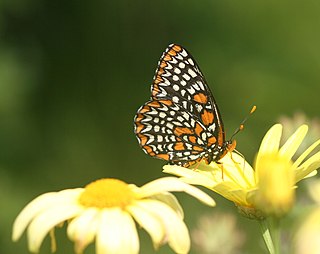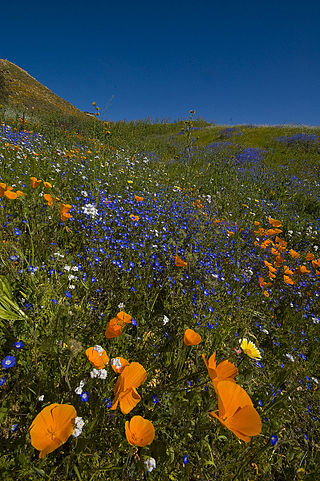
A pollinator is an animal that moves pollen from the male anther of a flower to the female stigma of a flower. This helps to bring about fertilization of the ovules in the flower by the male gametes from the pollen grains.

A bumblebee is any of over 250 species in the genus Bombus, part of Apidae, one of the bee families. This genus is the only extant group in the tribe Bombini, though a few extinct related genera are known from fossils. They are found primarily in higher altitudes or latitudes in the Northern Hemisphere, although they are also found in South America, where a few lowland tropical species have been identified. European bumblebees have also been introduced to New Zealand and Tasmania. Female bumblebees can sting repeatedly, but generally ignore humans and other animals.

Pollination is the transfer of pollen from an anther of a plant to the stigma of a plant, later enabling fertilisation and the production of seeds, most often by an animal or by wind. Pollinating agents can be animals such as insects, for example beetles; birds, butterflies, and bats; water; wind; and even plants themselves. Pollinating animals travel from plant to plant carrying pollen on their bodies in a vital interaction that allows the transfer of genetic material critical to the reproductive system of most flowering plants. When self-pollination occurs within a closed flower. Pollination often occurs within a species. When pollination occurs between species, it can produce hybrid offspring in nature and in plant breeding work.

Zoophily, or zoogamy, is a form of pollination whereby pollen is transferred by animals, usually by invertebrates but in some cases vertebrates, particularly birds and bats, but also by other animals. Zoophilous species frequently have evolved mechanisms to make themselves more appealing to the particular type of pollinator, e.g. brightly colored or scented flowers, nectar, and appealing shapes and patterns. These plant-animal relationships are often mutually beneficial because of the food source provided in exchange for pollination.

Bombus terrestris, the buff-tailed bumblebee or large earth bumblebee, is one of the most numerous bumblebee species in Europe. It is one of the main species used in greenhouse pollination, and so can be found in many countries and areas where it is not native, such as Tasmania. Moreover, it is a eusocial insect with an overlap of generations, a division of labour, and cooperative brood care. The queen is monandrous which means she mates with only one male. B. terrestris workers learn flower colours and forage efficiently.

Nectar is a sugar-rich liquid produced by plants in glands called nectaries or nectarines, either within the flowers with which it attracts pollinating animals, or by extrafloral nectaries, which provide a nutrient source to animal mutualists, which in turn provide herbivore protection. Common nectar-consuming pollinators include mosquitoes, hoverflies, wasps, bees, butterflies and moths, hummingbirds, honeyeaters and bats. Nectar plays a crucial role in the foraging economics and evolution of nectar-eating species; for example, nectar foraging behavior is largely responsible for the divergent evolution of the African honey bee, A. m. scutellata and the western honey bee.

In zoology, a nectarivore is an animal which derives its energy and nutrient requirements from a diet consisting mainly or exclusively of the sugar-rich nectar produced by flowering plants.

Ornithophily or bird pollination is the pollination of flowering plants by birds. This sometimes coevolutionary association is derived from insect pollination (entomophily) and is particularly well developed in some parts of the world, especially in the tropics, Southern Africa, and on some island chains. The association involves several distinctive plant adaptations forming a "pollination syndrome". The plants typically have colourful, often red, flowers with long tubular structures holding ample nectar and orientations of the stamen and stigma that ensure contact with the pollinator. Birds involved in ornithophily tend to be specialist nectarivores with brushy tongues and long bills, that are either capable of hovering flight or light enough to perch on the flower structures.

In zoology, a palynivore /pəˈlɪnəvɔːɹ/, meaning "pollen eater" is an herbivorous animal which selectively eats the nutrient-rich pollen produced by angiosperms and gymnosperms. Most true palynivores are insects or mites. The category in its strictest application includes most bees, and a few kinds of wasps, as pollen is often the only solid food consumed by all life stages in these insects. However, the category can be extended to include more diverse species. For example, palynivorous mites and thrips typically feed on the liquid content of the pollen grains without actually consuming the exine, or the solid portion of the grain. Additionally, the list is expanded greatly if one takes into consideration species where either the larval or adult stage feeds on pollen, but not both. There are other wasps which are in this category, as well as many beetles, flies, butterflies, and moths. One such example of a bee species that only consumes pollen in its larval stage is the Apis mellifera carnica. There is a vast array of insects that will feed opportunistically on pollen, as will various birds, orb-weaving spiders and other nectarivores.

Pollination syndromes are suites of flower traits that have evolved in response to natural selection imposed by different pollen vectors, which can be abiotic or biotic, such as birds, bees, flies, and so forth through a process called pollinator-mediated selection. These traits include flower shape, size, colour, odour, reward type and amount, nectar composition, timing of flowering, etc. For example, tubular red flowers with copious nectar often attract birds; foul smelling flowers attract carrion flies or beetles, etc.

Nectar robbing is a foraging behavior utilized by some organisms that feed on floral nectar, carried out by feeding from holes bitten in flowers, rather than by entering through the flowers' natural openings. "Nectar robbers" usually feed in this way, avoiding contact with the floral reproductive structures, and therefore do not facilitate plant reproduction via pollination. Because many species that act as pollinators also act as nectar robbers, nectar robbing is considered to be a form of exploitation of plant-pollinator mutualism. While there is variation in the dependency on nectar for robber species, most species rob facultatively.

Bombus lapidarius is a species of bumblebee in the subgenus Melanobombus. Commonly known as the red-tailed bumblebee, B. lapidarius can be found throughout much of Central Europe. Known for its distinctive black and red body, this social bee is important in pollination.

Bombus hortorum, the garden bumblebee or small garden bumblebee, is a species of bumblebee found in most of Europe north to 70°N, as well as parts of Asia and New Zealand. It is distinguished from most other bumblebees by its long tongue used for feeding on pollen in deep-flowered plants. Accordingly, this bumblebee mainly visits flowers with deep corollae, such as deadnettles, ground ivy, vetches, clovers, comfrey, foxglove, and thistles. They have a good visual memory, which aids them in navigating the territory close to their habitat and seeking out food sources.

Flower constancy or pollinator constancy is the tendency of individual pollinators to exclusively visit certain flower species or morphs within a species, bypassing other available flower species that could potentially contain more nectar. This type of foraging behavior puts selective pressures on floral traits in a process called pollinator-mediated selection. Flower constancy is different from other types of insect specialization such as innate preferences for certain colors or flower types, or the tendency of pollinators to visit the most rewarding and abundant flowers.

Bombus occidentalis, the western bumblebee, is one of around 30 bumblebee species present in the western United States and western Canada. A recent review of all of its close relatives worldwide appears to have confirmed its status as a separate species.

Frequency-dependent foraging is defined as the tendency of an individual to selectively forage on a certain species or morph based on its relative frequency within a population. Specifically for pollinators, this refers to the tendency to visit a particular floral morph or plant species based on its frequency within the local plant community, even if nectar rewards are equivalent amongst different morphs. Pollinators that forage in a frequency-dependent manner will exhibit flower constancy for a certain morph, but the preferred floral type will be dependent on its frequency. Additionally, frequency-dependent foraging differs from density-dependent foraging as the latter considers the absolute number of certain morphs per unit area as a factor influencing pollinator choice. Although density of a morph will be related to its frequency, common morphs are still preferred when overall plant densities are high.

Bumblebees, like the honeybee collect nectar and pollen from flowers and store them for food. Many individuals must be recruited to forage for food to provide for the hive. Some bee species have highly developed ways of communicating with each other about the location and quality of food resources ranging from physical to chemical displays.

Bombus impatiens, the common eastern bumble bee, is the most commonly encountered bumblebee across much of eastern North America. They can be found in the Eastern temperate forest region of the eastern United States, southern Canada, and the eastern Great Plains. Because of their great adaptability, they can live in country, suburbs, and even urban cities. This adaptability makes them a great pollinator species, leading to an increase in their commercial use by the greenhouse industry. This increase consequently led to their farther spread outside their previous distribution range. They are considered one of the most important species of pollinator bees in North America.

Insect cognition describes the mental capacities and study of those capacities in insects. The field developed from comparative psychology where early studies focused more on animal behavior. Researchers have examined insect cognition in bees, fruit flies, and wasps.

Floral Isolation is a form of reproductive isolation found in angiosperms. Reproductive isolation is the process of species evolving mechanisms to prevent reproduction with other species. In plants, this is accomplished through the manipulation of the pollinator’s behavior or through morphological characteristics of flowers that favor intraspecific pollen transfer. Preventing interbreeding prevents hybridization and gene flow between the species (introgression), and consequently protects genetic integrity of the species. Reproductive isolation occurs in many organisms, and floral isolation is one form present in plants. Floral isolation occurs prior to pollination, and is divided into two types of isolation: morphological isolation and ethological isolation. Floral isolation was championed by Verne Grant in the 1900s as an important mechanism of reproductive isolation in plants.





















